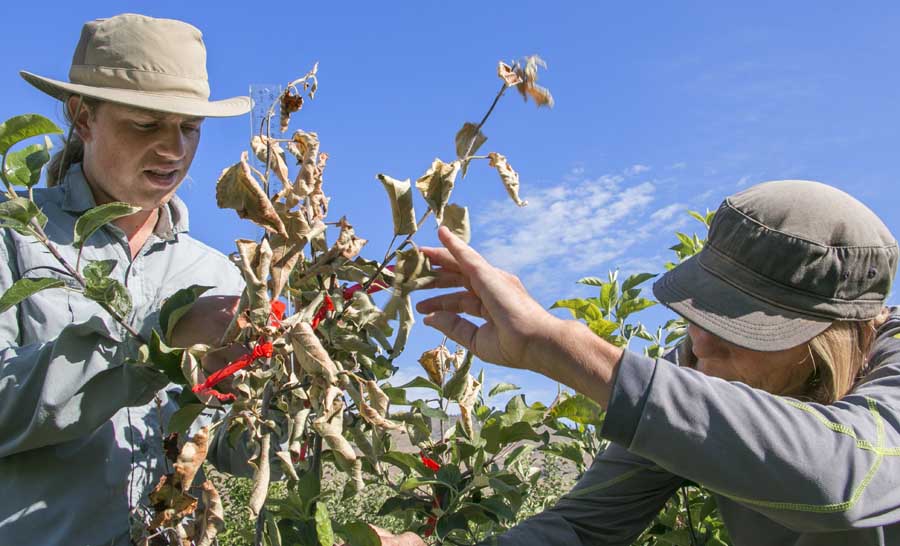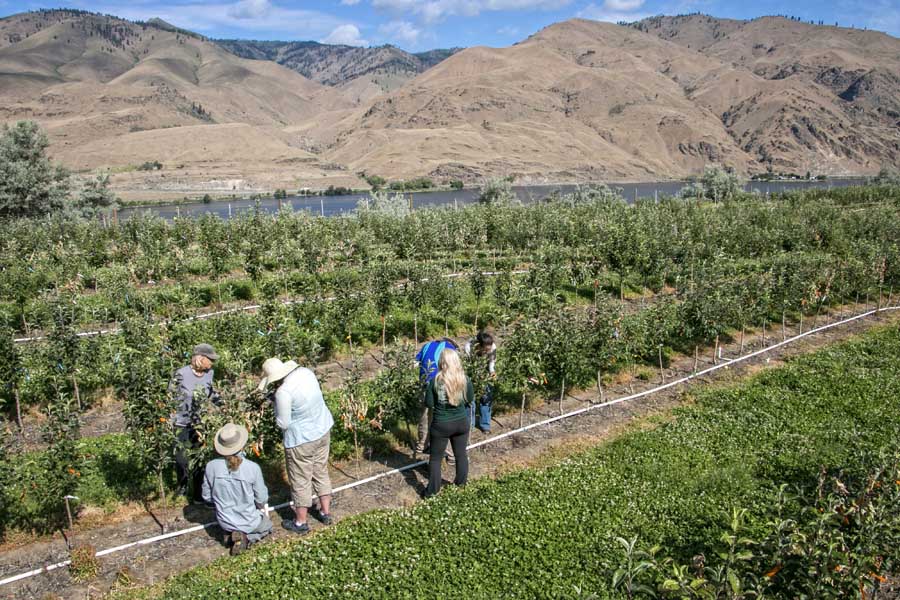
Jamie Coggins, a graduate student, and Bonnie Schonberg, a research technician, measure the effects of fire blight on apple trees during a trial at Washington State University’s Columbia View research orchard near Orondo, Washington, in June. (Ross Courtney/Good Fruit Grower)
This past summer, a team of researchers armed with scissors walked through a North Central Washington apple orchard and did the unthinkable: They inoculated 1,600 trees with fire blight.
They’re not aiming to wipe out an orchard. Rather, they’re trying to identify the genes responsible for fire blight resistance in different apple cultivars and, ultimately, employ that information to develop new fire blight-resistant varieties.
Pear growers have long known about the challenges posed by fire blight, caused by the bacterial pathogen Erwinia amylovora, and it’s become more of an issue for apple orchardists as the number of new planted varieties grows.
“It wasn’t a problem when we were growing Red Delicious, because Red Delicious is pretty well resistant to fire blight,” said Kate Evans, Washington State University apple breeder who is leading this fire blight study. “But as other varieties are coming in and growers are planting them, it’s becoming more of an issue.”
Expanding the genotyping
Researchers across the country have been working several years to establish genotypic information on different cultivars of different crops. Called the RosBREED program, its aim was to improve and speed up breeding programs by identifying the DNA markers for desirable fruit qualities.
The RosBREED 2 program aims to maximize the output from the first program by adding disease resistance markers to the search.

Technicians and students analyze apple varieties for resistance to fire blight at the Columbia View orchard in Wenatchee. (Ross Courtney/Good Fruit Grower)
For instance, Evans and her team already had gathered genetic and fruit quality information for 1,600 trees — 350 cultivars — in that research orchard. But if she could determine the fire blight resistance of the trees, she could get new information from the same trees.
“First, we might be able to identify some other sources of resistance we weren’t aware of,” she said. The trees largely represent normal dessert apple germ-plasm, rather than more small fruited crabapple types, some of which are resistant to fire blight. “It would be great if we could identify some germplasm with some level of resistance that we could then use in the breeding program.”
The other potential gain: Because researchers already have genotypic information for these trees, they may be able to identify some linked markers in their DNA associated with fire blight resistance, which would enable them to use DNA screening to predict which trees in the breeding program will be resistant to fire blight.
Taken together, newly identified resistance genes and development of DNA markers enable researchers to pyramid multiple resistance genes, thereby improving the durability of the resistance and the efficiency of the breeding program.
The research

Ooze drips from an apple tree affected by fire blight at the Columbia View orchard in Wenatchee. (Ross Courtney/Good Fruit Grower)
Evans and her team couldn’t really inoculate her original research orchard, because the risk was too high that it would destroy the trees. Instead, she had to establish a new planting to conduct the experiments.
“For a lot of diseases, like apple scab, the disease is usually widespread and uniform. It won’t kill the tree. With fire blight, it’s a much more sporadic disease and unless you do actually challenge the tree with the pathogen, you don’t get reliable data on susceptibility,” said Jay Norelli, a plant pathologist at the U.S. Department of Agriculture’s research station in Kearneysville, West Virginia.
Norelli, who is leading the disease research for the RosBREED project and collaborating with Evans on this trial, has been working to characterize the underlying basis of disease resistance in fruit trees and to develop novel control strategies for specific diseases, including fire blight.
Thus, the scissors to the trees. So far the trees have shown a range of responses in the first year of study.
“We had great infection,” she said with a laugh. “By seeing symptoms, you know there wasn’t a problem with your inoculation, but we certainly saw some individuals that weren’t showing any symptoms either.”
The results have provided a great data set for the first year, Evans said, and she intends to continue the work next year.
“You can’t do this kind of study on just one year’s data; it’s not informative enough,” she said. “There will be some trees that won’t make it to next year, but for those that weren’t showing any symptoms, we really need to repeat the process so that we’re confident with the data set that we’re going to use going forward.” •
Targeting for tolerance
Jay Norelli, a plant pathologist at the U.S. Department of Agriculture who is leading the disease research for the RosBREED project, has been working to characterize the underlying basis of disease resistance in fruit trees and to develop novel control strategies for specific diseases, including fire blight.
Specifically, he and others are targeting specific cultivars that they know are fire blight tolerant and have good fruit quality, including Splendor, a New Zealand cultivar that isn’t grown in the United States and never really made it onto the commercial market due to storage issues. “It has excellent flavor though and has been used in many breeding programs,” he said.
Outside of the RosBREED project, Norelli and Kate Evans of Washington State University also have identified some individuals of the wild progenitor of apple, Malus sieversii, that are highly resistant to fire blight.
“We are trying to do that directed genetic analysis by making crosses,” he said, which would introduce into the breeding program a much higher level of resistance, but because it involves breeding new varieties, rather than identifying resistance in existing varieties, “that approach will take a lot longer.”
“Even when starting out with good cultivars, like Splendor, the development of a new cultivar for fruit trees still takes a long time, and it takes a long time for it to be accepted by the industry,” he said. “It’s a major undertaking.”
– by Shannon Dininny






Leave A Comment